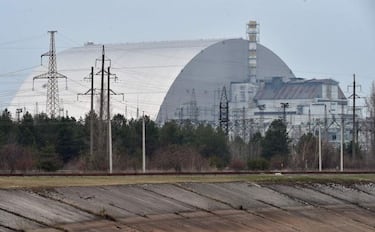How big was Chernobyl, how many people died, and how far did the damage extend? Map of fallout
As Russian troops stormed the nuclear facility at Zaporizhzhia, Ukrainian officials warned an accident there would be ten times worse than Chernobyl.

Chernobyl was the worst manmade disaster in history that still has lingering effects today. Russia is trying to get its hands on Ukraine’s nuclear power plants, capturing Chernobyl, which is decommissioned, and now Zaporizhzhia, the largest active nuclear power plant in Europe.
Zaporizhzhia contains six of Ukraine’s 15 active nuclear reactors. Dmytro Kuleba, the Ukraine Foreign Minister, warned that if it blew up, the catastrophe would be ten times that of Chernobyl.
Also see:
- Watch Zelensky documentary 'Servant of the People'
- Zaporizhzhia nuclear power plant stable after Russian attack
- Ukraine jets strike Russian military convoy
- More than one million people have fled Ukraine since the invasion began
- Where are the Russian troops in Ukraine?
How Chernobyl and Zaporizhzhia compare
Ukraine relies heavily nuclear power for its energy grid making up over half the country’s total generation mix. The Zaporizhzhia nuclear power plant has a total capacity of about 6,000 megawatts representing almost 50 percent of nation’s nuclear-generated power.
By the time of the accident in 1986 at the Chernobyl nuclear power plant four of the six planned nuclear reactors had been completed and brought online. The facility had a capacity of around 3,500 megawatts but the last reactor was decommissioned in 2000.
Radiation from Chernobyl spread far beyond the “exclusion zone”
Over the years, some 350,000 people have been relocated due to the Chernobyl accident according to the World Nuclear Association. The exclusion zone, which is essentially uninhabited, originally extended 30 kilometers encompassing around 2,800 square kilometers, from the site of the decommissioned nuclear power plant. Later it was modified, now covering roughly 4,300 square kilometers.
This is a radiation fallout map of Chernobyl disaster.
— Fuad Alakbarov (@DrAlakbarov) March 4, 2022
So how things can look if there is a leak from Zaporizhia nuclear power plant? pic.twitter.com/rKYgElogmV
At the time of the accident, radiation from the damaged reactor number four was dispersed in the atmosphere. The rest of the world was unaware of the accident until radiation alarms went off at Sweden's second largest nuclear power plant Forsmark. That discovery forced the Soviet Union to acknowledge the accident.
Eventually, radioactive fallout spread over much of the northern hemisphere but amounts in most parts were insignificant. The International Atomic Energy Agency (IAEA) states that around 150,000 square kilometers in Belarus, Russia and Ukraine are contaminated.
Only 50 deaths are directly attributed to the Chernobyl accident
The true death toll of the Chernobyl disaster is difficult to judge because of the long-lasting health effects of radioactive pollution. The official death toll directly attributed to Chernobyl that is recognized by the international community is just 31 people with the UN saying it could be 50.

However, hundreds of thousands of “liquidators” were sent in to put out the fire at the nuclear power plant and clean up the Chernobyl site afterwards. The number could be as high as 830,000 but only 600,000 were given official status which comes with significant social benefits for healthcare and retirement.
Related stories
Death and disability rates among liquidators soared over the years. However, health studies on them have not shown “any direct correlation between their radiation exposure and an increase in other forms of cancer or disease,” according to the IAEA. Psychological trauma from Chernobyl remains widespread and profound resulting in “suicides, drinking problems and apathy.”
There number of documented cases of thyroid cancer in children has also been far higher than normal. Young children are particularly susceptible to absorbing radioactive iodine, which was ejected from the core of Chernobyl, which can trigger cancers.
- Chernobyl
- Russian invasion of Ukraine
- Nuclear accidents
- Radioactive decontamination
- Ukraine
- Radioactive pollution
- Radioactivity
- Decontamination
- Nuclear energy
- Russia
- Accidents
- Eastern Europe
- Pollution
- Environmental protection
- Europe
- Accidents and crimes
- War
- Environmental problems
- Conflictos armados
- Conflicts
- Environment
- Energy


